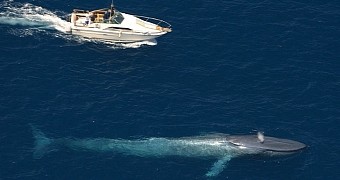Researchers with the University of Washington in the US have some really good news to share with wildlife enthusiasts: according to recent surveys, blue whales have made a comeback in the waters off the coast of California.
More precisely, it appears that the local blue whale population is now roughly the same as it was decades ago, before humans started hunting these marine mammals.
What's interesting is that the California blue whale population has rebounded to near historical levels despite the fact that collisions between such marine mammals and ships cruising these waters are still fairly common.
In a paper published in the journal Marine Mammal Science this past September 5, the University of Washington specialists detail that the whale population currently comprises around 2,200 individuals.
This figure represents approximately 97% of the average historical level documented for this part of the world, and stands as proof that, if given the chance, blue whales can recover from years of intense hunting operations, the researchers go on to explain.
“The recovery of California blue whales from whaling demonstrates the ability of blue whale populations to rebuild under careful management and conservation measures,” doctoral student Cole Monnahan said in a statement.
“California blue whales are recovering because we took actions to stop catches and start monitoring. If we hadn’t, the population might have been pushed to near extinction – an unfortunate fate suffered by other blue whale populations,” he added.
To put things into perspective, it need be said that, between the years 1905 and 1971, some 3,400 blue whales were tracked down and killed in California waters. Simply put, these marine mammals and humans weren't exactly the best of friends prior to the introduction of conservation measures.
Blue whales are among the largest animals on Earth. Thus, adults measure about 100 feet (roughly 30.5 feet) from head to tail, and tip the scale at around 190 tons. In the US, they populate the waters stretching from the equator up to the Gulf of Alaska, and are most often spotted feeding off the California coast.
Blue whales in California waters might have made a comeback, but this does not change the fact that, due to unsustainable hunting practices, the species is still in danger of falling off the biodiversity map sometime in the not-so-distant future.
In fact, the International Union for Conservation of Nature currently lists blue whales as an endangered species. The good news is that, as shown by this investigation carried out by University of Washington researchers, it is possible to save blue whales from going extinct by protecting their habitat and not allowing whalers to continue hunting them.

 14 DAY TRIAL //
14 DAY TRIAL //